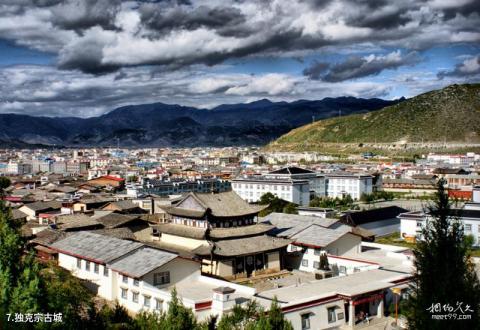
Introduction to Dukezong Ancient City: Dukezong Ancient City is the best-preserved and largest Tibetan settlement in China, and is the hub of the Ancient Tea Horse Road. It was built according to the Shambhala Utopia in the Buddhist scriptures. It has a history of more than 1,300 years. During the Tang Dynasty, northwest Yunnan (including the Diqing area) belonged to the Tubo Dynasty. From 676 to 679 years in the Tang Dynasty, Tubo established the Shenchuan Governor's Palace in Weixi, and established an official village in today's Dagui Mountain. It was built with stone as a city. The city was named "Duke Zong", which is the famous "Iron Bridge East City" in history. ". Legend has it that the idea of building the city at that time was due to a living Buddha looking at the ancient city from the hilltop opposite the ancient city. He found that the Big Turtle Mountain looked like Master Padmasambhava sitting on a lotus. Therefore, the construction layout of the ancient city was shaped like an eight-petal lotus, forming a space that changes naturally. In the construction of the ancient city, most of the building materials were sourced locally. Craftsmen discovered that a kind of white clay produced locally could be used as paint for the exterior walls of houses, so the exterior walls of houses in the ancient city were painted white. This style is still used today. On a moonlit night, the silver moonlight made the white ancient city look particularly enchanting, so the locals called the ancient city "Duke Zong". "Duke Zong" means white stone city in Tibetan, implying the moonlight city.
In the Ming Dynasty, Zhongdian was occupied twice by the chieftain of the Mu clan of Lijiang. The chieftain of the Mu clan built the "Xianggewa" village in Daguishan, which means Shishan Village in Tibetan. The site was the original "Duke Zong" of Daguishan. . Later, the "Dani Yuwa" village was built on the bank of Naizi River, which was called "Niwang Zong" in Tibetan, which means Sunlight City. The two villages echo each other and form the famous "Xianggoniwa" in Zhongdian history, which is also the famous "Sun and Moon City" in Tibetan areas.
The ancient city of Dukezong has always been the thoroughfare for tea and horse trade between Yunnan, Sichuan and Tibet. In the 27th year of Kangxi (1688), the Dalai Lama requested trade on the Jinsha River, and the Qing government allowed the establishment of a market in Zhongdian. Dukezong Zong became an important market for Yunnan-Tibet trade. During the reigns of Yongzheng and Qianlong, the mining industry was booming and merchants from all over the country gathered. During the Anti-Japanese War, the Japanese invaders occupied Burma and cut off transportation between Yunnan and Burma. Large quantities of aid supplies to China could only be transported across the Himalayas from Lhasa to Kunming via northwest Yunnan. The county town became a transit point for trade between Yunnan, Tibet and India. The Russian Mr. Peter Gu described this in his famous book "The Forgotten Kingdom": It is estimated that when all routes into China were blocked during the war, this "caravan transport" used 8,000 mules and Twenty thousand yaks.
Transportation information: (Passenger bus) There is a direct tourist line from Shangri-La County.
Scenic spot location: Shangri-La County, Diqing Tibetan Autonomous Prefecture, Yunnan Province. Tel: (0887)8223310
